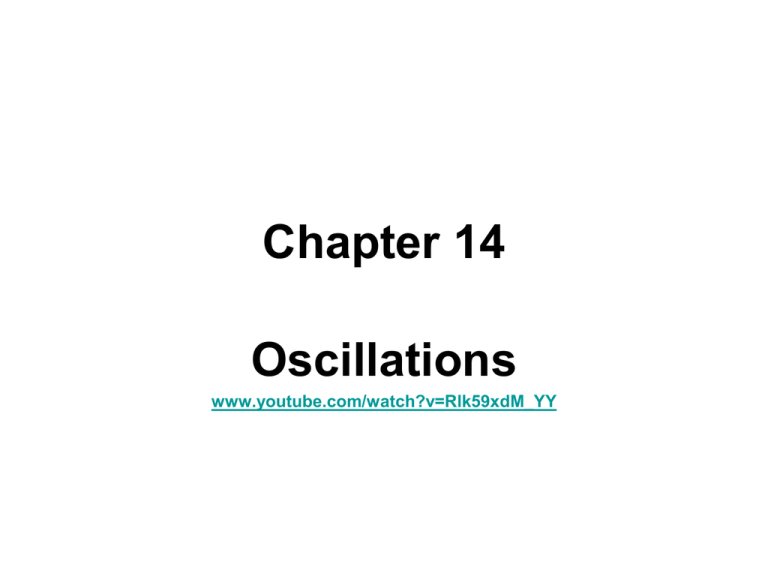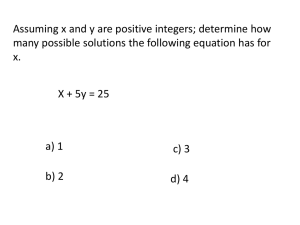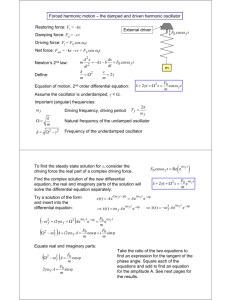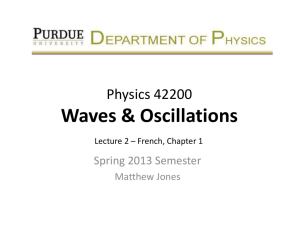Chapter 14 - galileo.harvard.edu
advertisement

Chapter 14 Oscillations www.youtube.com/watch?v=Rlk59xdM_YY Introduction • Oscillations of a Spring (Hands-on emphasis) • Simple Harmonic Motion (Mathematical emphasis) • Pendulums - Simple & beyond simple • Damped Harmonic Motion (Modeling emphasis) • Driven Damped Harmonic Motion & Resonance (the grand finale) Oscillations of a Spring • Characteristics – Amplitude – Period – Frequency – Phase • Discovery Lab (Handout) • Lab Project Assignment introduced Simple Harmonic Motion • Mathematical Representation – Equation of motion (Simple common phenomenon using Classical Mechanics) – Solution exercise – Role of initial conditions – Phase angle – Angular frequency and frequency – Natural frequency • Relation to Uniform Circular Motion • Examples (Physlets) Energy and SHM • Kinetic energy of object in SHM • Spring potential energy • Potential energy graphical representation – Whiteboard exercise • Jeopardy problems 1 2 3 4 5 Pendulums • Simple pendulum – Equation of motion – Approximation sin(θ) ≈ θ • Handout or Exercise – Solution • Physical Pendulum • Torsion Pendulum Damped Harmonic Motion • Equation of motion and solution – Damping – Over-damped, Under-damped, Critical damping & Physlet • Mathematical modeling – Stella model (later) Driven Damped Harmonic Motion & Resonance • • • • Driven (Forced) situations Equation of motion and solution Mathematical modeling continued Resonance – What? and When? – Examples (including “field trip”) – Q-value the end Is the function Asin(ωt + ø) a solution of the general simple harmonic motion equation? If so, what are the constraints on ω, A and ø? back To what question is this the answer? (1/2)(1kg)v2 = (1/2)(2N/m)(.2m)2 next back To what question is this the answer? (1/2)(1kg)v2 + (1/2)(1N/m)(-.2m)2 = (1/2)(1N/m)(.4m)2 next back To what question is this the answer? (1/2)(3N/m)x2 = (1/2)(1kg)(1m/s)2 next back To what question is this the answer? (1/2)(2N/m)(.2m)2 = (1/2)(1N/m)x2 next back To what question is this the answer? (1/2)(1kg)(2m/s)2 = (1/2)k(2m)2 back Physlet E16.1 period vs. amplitude (spring and pendulum) Physlet E16.3 position and velocity Physlet E16.6 under, critical, overdamped Physlet E16.6 resonance (find f(resonant), m) http://phet.colorado.edu/new/simulations/sims.php?sim=Masses_and_Springs http://phet.colorado.edu/new/simulations/sims.php?sim=Masses_and_Springs At the point P, the mass has _______ and _______. displacement 1.5 1 P 0.5 time 0 0 0.2 0.4 0.6 0.8 1 -0.5 -1 -1.5 1) v>0, a>0 4) v>0, a=0 7) v>0, a<0 2) v=0, a>0 5) v=0, a=0 8) v=0, a<0 3) v<0, a>0 6) v<0, a=0 9) v<0, a<0 Physlet E16.3 position and velocity A mass oscillates on a spring. Consider two possibilities: (i) v=0 and a=0 at some point in time. (ii) v=0 at some point, but a≠0 at that point. Which are true? 1)Both are. 2)Neither are. 3)Only (i) 4)Only (ii) Which of the following functions satisfy the given differential equation? dy 3 y dt 1) 2) 3) 4) 5) 6) t Ae Ae Bt t Ate t Ae Ate At B Bt Which of the following functions satisfy the given differential equation? d2y dy 2 y 2 dt dt 1) 2) 3) 4) 5) 6) t Ae Ae Bt t Ate t Ae Ate At B Bt Which of the following functions satisfy the given differential equation? dy t ye dt 1) 2) 3) 4) 5) 6) t Ae Ae Bt t Ate t Ae Ate At B Bt Which of the following functions satisfy the given differential equation? d2y y 2 dt 1) 2) 3) 4) 5) 6) t Ae A cos(t ) A sin(t ) Bt Ae cos t Ae Bt sin t At B Rank on the basis of time to complete one cycle. (Least to greatest) 0.4m stretch A 1kg 0.5m stretch D 5N/m 1kg 1N/m 0.2m stretch B 2kg 0.5m stretch E 5N/m 4kg 4N/m 0.5m stretch 0.2m stretch C 5kg 4N/m F 5kg 1N/m A mass is hanging in equilibrium via a spring. When it is pulled down, what happens to the total potential energy (gravity + spring)? 1)It increases. 2)It stays the same. 3)It decreases. Rank on the basis of time to complete one cycle. (Least to greatest) A y 6sin(3t ) B y 3sin(6t ) C y 6 cos(3t ) D y 6sin(3t 30) E y 10 cos(6t ) F y 10 cos(2t ) Rank according to maximum velocity. (Least to greatest) A y 6 cos(3t ) B y 3cos(6t ) C y 3cos(3t ) D y 6 cos(1.5t ) E y 3cos(1.5t ) F y 10 cos(2t ) Rank according to maximum acceleration. (Least to greatest) A y 6 cos(3t ) B y 3cos(6t ) C y 3cos(3t ) D y 6 cos(1.5t ) E y 3cos(1.5t ) F y 10 cos(2t ) Physlet E16.5,6 resonance Physlet P16.3 Physlet P16.6 Which falls faster? A: Meter stick 1) 2) 3) 4) B: Meter stick with heavy clamp A B Same. More info is needed. A pendulum is in an elevator that approaching the top floor of a building and is coming to a stop. What happens to the period of the pendulum? 1) 2) 3) 4) It increases. It stays the same. It decreases. More info is needed. Which, if any, of the following functions satisfy the given differential equation? d2y y 2 dt 1) 2) 3) 4) 5) 6) A cos(t ) A sin(t ) t Ae Bt Ae cos t Ae Bt sin t At B Which, if any, of the following functions satisfy the given differential equation? dy 3y dt 1) 2) 3) 4) 5) 6) t Ae Ae Bt t Ate t Ae Ate At B Bt Which, if any, of the following functions satisfy the given differential equation? d2y dy 2 y 2 dt dt 1) 2) 3) 4) 5) 6) t Ae Ae Bt t Ate t Ae Ate At B Bt Which, if any, of the following functions satisfy the given differential equation? dy t ye dt 1) 2) 3) 4) 5) 6) t Ae Ae Bt t Ate t Ae Ate At B Bt Physlet 16.12 Floating oscillator








